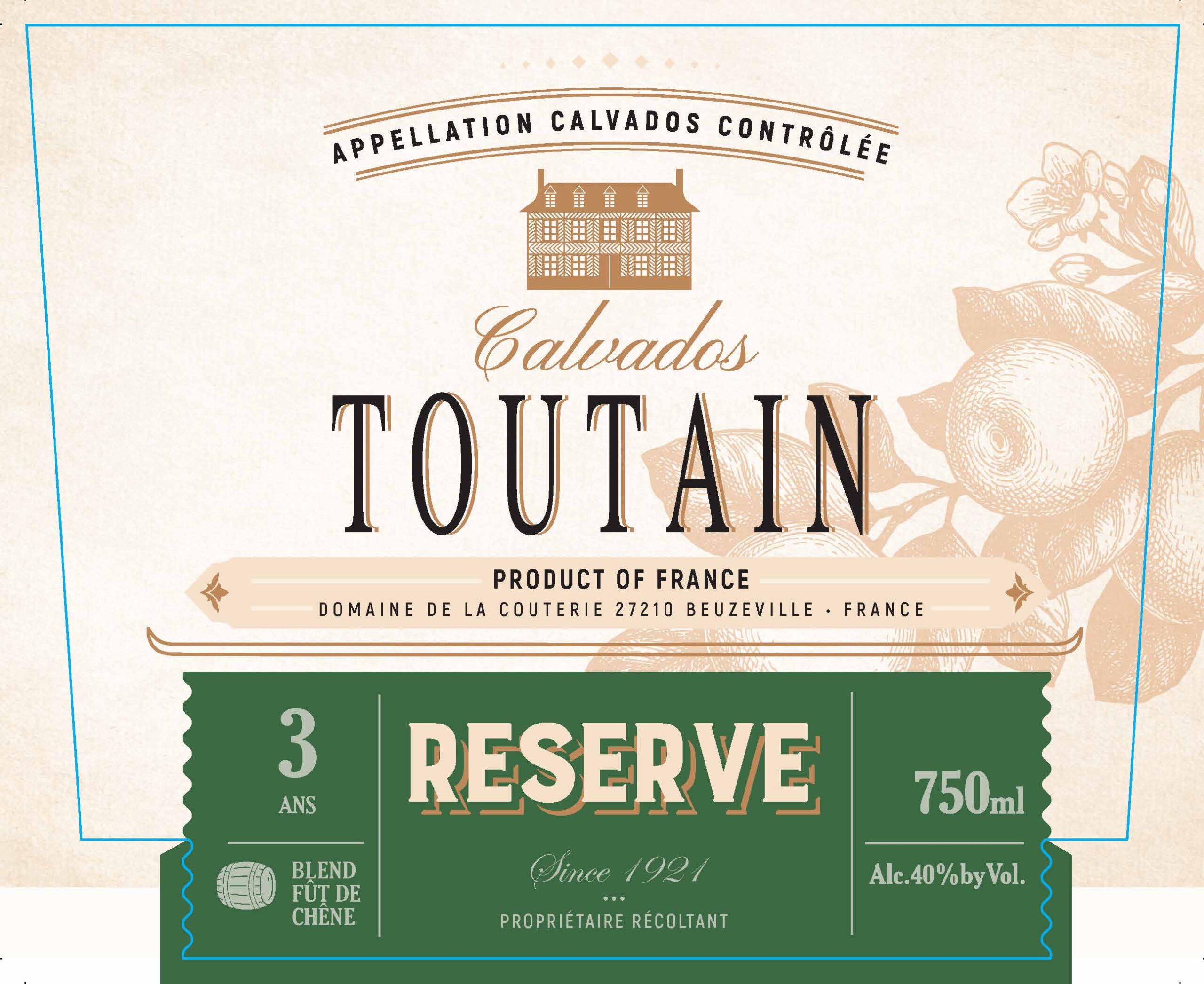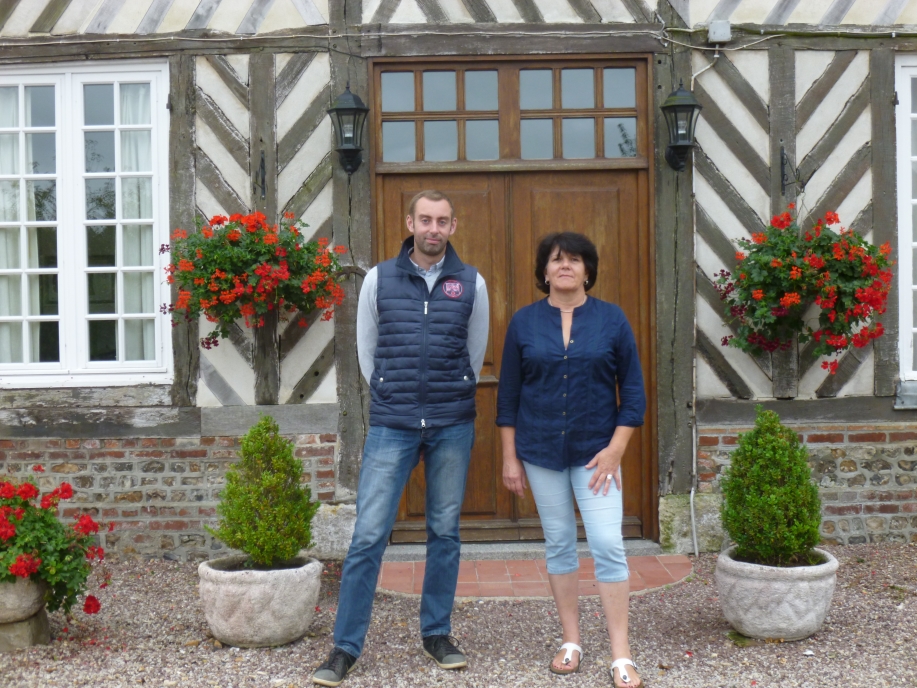Toutain, Normandy

| Country & Region | France, Normandy |
| Appellation(s) | Calvados |
| Producer | Corinne and Maxime Lamiot |
| Founded | 1921 |
| Website | www.calvadostoutain.com |
The domain is La Couterie, the family is Toutain, and they’ve been distilling apple cider into Calvados for five generations, or since 1921 (commercially, that is; prior to ’21 the tax man knew nothing). This is a family of ardent traditionalists. They cultivate their orchards in the old hautes-tiges manner, season new barrels thoroughly with cider to keep the flavor of wood out of their spirits, and never distill any cider before it’s fermented and aged for six to eighteen months. Last but far from least, they use no additives—be it flavor enhancers, coloring agents, or sugar—and put no yeast into their cider ferments. It goes without saying that their orchards have been farmed organically for as long as anyone can remember.
With the invention of the apple press in the 13th century, cider production became possible on a wide scale. In the same century, King Louis IX banned barley beer as a way of mitigating famine, and so apple farming for cider production quickly developed in northern France. As for the transformation of cider into eau de vie, the written record dates from 1553, when a nobleman (and tireless apple scholar) on the Cotentin Peninsula noted in his journal that he had just made distillate from cider.

The practice needed little encouragement to take off. When, however, the system of hautes-tiges, or high tree (standard rootstock) orchards became more or less systematic—with a tree planted every ten meters, or 100 trees to a hectare—isn’t as clear, but the practice was widespread by the 19th century. The last quarter of the 20th century witnessed a revolution in apple orchard practices caused by the adaptation of dwarf rootstocks (basses-tiges) and semi-dwarf rootstocks (demi-tiges). These modern plantings have densities anywhere from five to ten times greater than the traditional hautes-tiges, and their advantage lies in efficiencies: such trees produce fruit at a much earlier age, require less land, and can be harvested by machine. On the other hand, their productive life is shorter, their close proximities require chemical treatments to ward off diseases, and they usually lack the genetic mix and diversity of traditional orchards. Finally, it’s argued that qualitatively their fruit is inferior. Nor, for what it’s worth, can a farmer graze dairy cattle in such orchards, as is typically done in traditional orchards.
The Toutains farm 62 acres (25 hectares) of orchards in 11 parcels, and cultivate 35 varieties, all inter-planted. These are the typical old cider varieties of northern France, Spain and England. Their domain of La Couterie is on the northwestern edge of Haute-Normandie, in a zone originally classed during World War II as Calvados du Pays de la Risle, after the Risle River. Today this zone, along with most of the other original zones, is classed simply as Calvados (made via single distillation, as is typical for Armagnac) and is grouped with two other appellations: Calvados Pays d’Auge (made via double distillation, standard for Cognac) and Calvados Domfrontais (single distillate made with a portion of pears rather than only apples). The Toutains all but sit on the Pays d’Auge border, and indeed half of their orchards are geographically within the Pays d’Auge. In 1997, 1999, and 2002 they actually double distilled some cider from their Pays d’Auge orchards across the border, and that Calvados is still in barrel in their cellars. They quit after 2002 because of logistical difficulties. A producer can make AOC Calvados in either region, whereas AOC Pays d’Auge can only be made in the Pays d’Auge—and the primary Toutain distillery is on the wrong side of the border. In 2015 the INAO granted them special dispensation and now all of their orchards are legally considered to be within the Pays d’Auge, but their production continues to be single-distilled and classified as AOC Calvados. In the years to come, they hope to build a new distillery to properly re-launch their production of Pays d’Auge.
Their apples are divided between those with sweet flavor profiles (60% of their plantings); those with bitter profiles (30%); and those with acid profiles (10%), necessitating three general harvests that altogether take from September until mid-December. Their orchards grow in deep silt soils on top of limestone.
Sixty pounds of apples translates into fifteen liters of cider, which in turn produces one liter of eau de vie out of a still. In its unadulterated state, the eau de vie comes in at 68-70% of alcohol and legally must be watered down to 40-45% to be commercialized. The Toutains use spring water or purified water and add a little each year to a given batch during the aging process.
They work with spontaneous ferments for their cider. Unlike larger, more commercially minded producers (those dastardly les industriels), the Toutains let their cider age properly for a minimum of six months and as long as eighteen months before undertaking the distillation process. Prior to distilling, the cider is taken off of the lees because the aim here is for purity of aromatics (above all) and of flavors. They bottle only around 5% of their production as cider; all else is distilled in one of their six old alembic stills. Maxime prefers to use column stills for distillation because these give him the fruitiest distillate, which is what he seeks. His stills are fired by natural gas, allowing the best control of the heat.
Their Calvados is aged in barrel and cask in sizes varying from standard Bordeaux barrels to enormous foudre, all old and many quite old (any new barrels chez Toutain spend their first three years aging cider before being used for the aging of distillate).
As for the Toutains themselves, Maxime started at the domain in 2007 and handles the orchards, production, and aging. His mother, Corinne, originally took over production in 1999 and now handles the bottling (she still welds a mallet to pound in the magnum corks!) as well as much of the administration. Maxime represents the fifth generation.
The Eaux-de-Vie
| Wine | Blend | Description |
|---|---|---|
| Cidre Bouché | From Maxime: “Our cider, like our Calvados, is completely "home-made" as in we pick our own apples, and we control the whole transforming process. We select and pick the right apples for cider making and press them down to obtain a sort of apple juice (which contains the pectin, spontaneous ferments, natural sugar, etc.) This apple juice is placed in a steel tank for about a week to allow the natural process of the solid matter separating from the liquid matter. Then we mix together four batches that we allow to ferment naturally. After 2 to 4 months' aging in tank, we lightly filter the cider before bottling. Our average annual production is around 6,300 bottles each year.” | |
| L'Innocente Bartender Series | Technically, this is an eau de vie de cidre blanche, an eau de vie made from apple cider but one that cannot be labeled Calvados because Calvados must see a minimum of three years aging in wood. L'Innocente sees none, hence the white spirit designation. This is the brainchild of Maxime, who fielded many requests from mixologists for a spirit that could be used in mixes as well as one that could be served straight with ice as an apéro. This comes from Toutain's orchards, specifically from 20 types of apples: 70% sweet varietals, 20% bitter-sweet, and 10% acid. The cider is aged in large old foudre for 18 months before being distilled into eau de vie, and then cut with spring water to bring the level of alcohol down to 40%. 22 cases |
|
| Réserve (minimum 3 years in barrel) | If you like the fragrance of apples bursting from your glass, this is your boy (and there is a school of thought out there that thinks young, inexpensive Calvados is the best because it is the most primary in scent and flavor and thus the purist). Aromatically fresh and powerful, this is an ideal spirit for cocktails and for kitchen preparations. 755 cases. |
|
| Hors d'Age (minimum 15 years in barrel) | What impresses one about the Toutain Calvados is their finesse, and the Hors d’Age cuvée has elegance in spades. Rich, round, and textured, with notes of tarte tatin and spiced apples, yet with plenty of youthful fruit to proclaim its origins. 300 cases. |